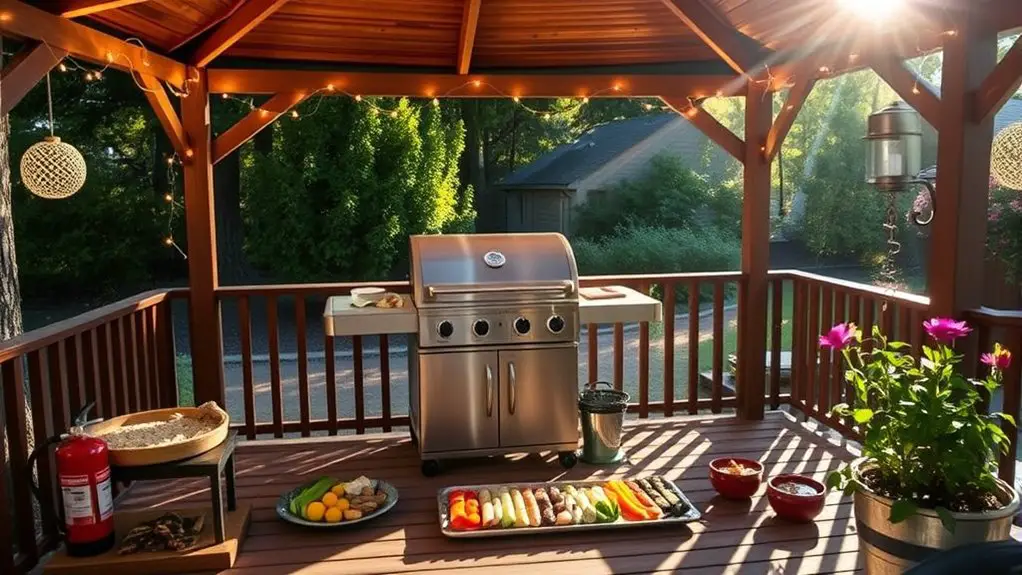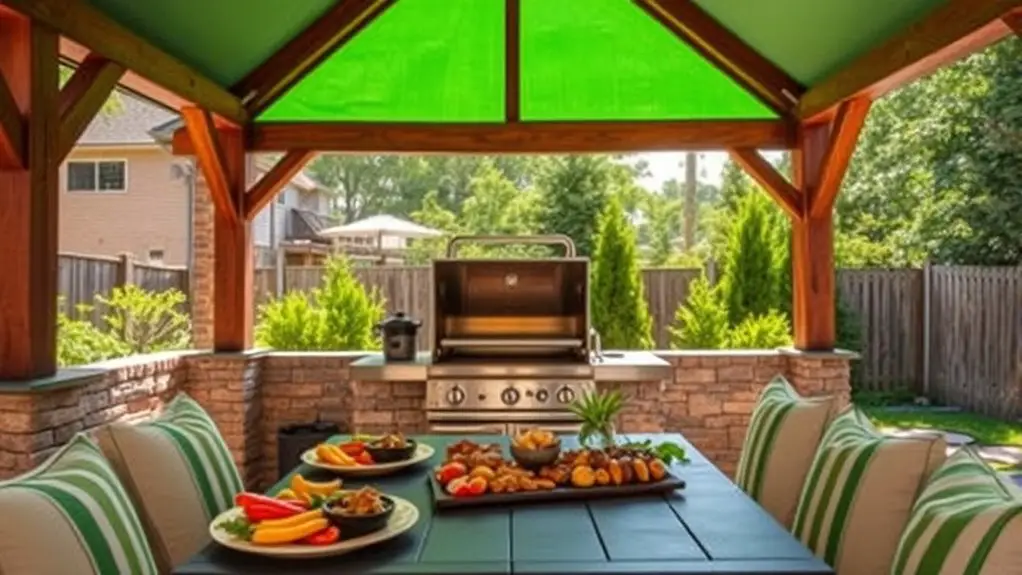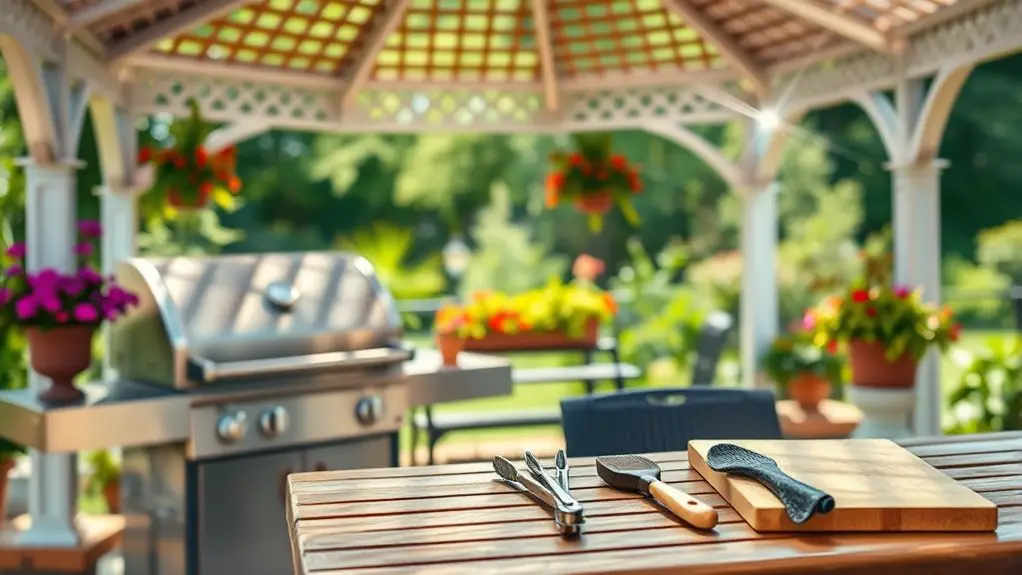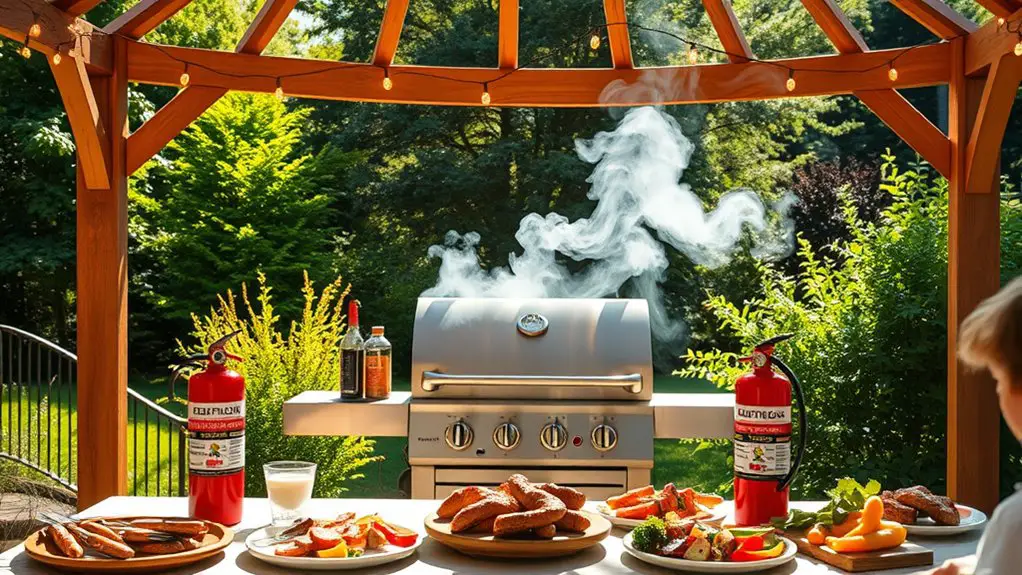When grilling in a gazebo, it’s crucial to prioritize safety. Always make certain proper ventilation by opening side panels and using exhaust fans to reduce smoke buildup. Maintain at least three feet of clearance from flammable structures and keep a Class B fire extinguisher nearby. Monitor cooking times carefully and be mindful of weather conditions. Store propane tanks securely outdoors, away from heat. Follow these tips, and you’ll create a safe and enjoyable grilling experience for everyone. Curious for more?
Choose the Right Grill

When it comes to grilling, choosing the right grill can make all the difference, whether you’re a weekend warrior or a seasoned pit master. You’ll find various grill types out there, each offering unique flavors and cooking experiences. Gas grills are convenient and heat up quickly, perfect for those who value efficiency. Charcoal grills, on the other hand, give you that classic smoky flavor, ideal for traditionalists. If you crave versatility, consider a pellet grill, which combines the ease of gas with the flavor of wood.
Next, think about fuel sources. Propane and natural gas are popular for their convenience, while charcoal and wood provide distinct tastes. Each choice impacts your grilling style and the overall flavor profile of your food. Ultimately, picking the right grill and fuel source empowers you to release your inner grill master, giving you the freedom to create mouthwatering dishes that impress family and friends. Additionally, ensure that proper ventilation is maintained when grilling under a gazebo to prevent smoke and gas buildup.
Ensure Proper Ventilation
To enjoy a safe and successful grilling experience, proper ventilation is key. Make sure to open side panels, use exhaust fans, and avoid any overhead coverings that could trap smoke and heat. By ensuring good airflow, you’ll keep your grill running efficiently and reduce the risk of dangerous flare-ups.
Open Side Panels
Guaranteeing proper ventilation is essential for successful BBQ grilling, as it allows for ideal airflow and temperature control. When you choose open panel designs for your gazebo, you greatly enhance ventilation effectiveness. These designs help smoke and heat escape, reducing the risk of buildup that can lead to dangerous situations. In addition, open side panels create a free-flowing environment, making your grilling experience more enjoyable and safe. You’ll find that the right airflow not only keeps temperatures manageable but also helps maintain the quality and flavor of your food. So, if you’re planning to grill under a gazebo, opt for those open panels to guarantee a well-ventilated and enjoyable barbecue session. Happy grilling!
Use Exhaust Fans
While open side panels greatly improve ventilation, adding exhaust fans can take your grilling setup to the next level. Proper fan placement is essential; positioning fans near the grill can help efficiently expel smoke and heat. Here’s a quick look at different exhaust fan types:
| Fan Type | Best Use | Key Features |
|---|---|---|
| Wall-Mounted | Small to medium spaces | Space-saving design |
| Ceiling-Mounted | Larger areas | Effective airflow |
| Portable | Versatile use | Easy to relocate |
Avoid Overhead Covering
If you’re serious about grilling, you should avoid overhead coverings that can trap smoke and heat, hindering proper ventilation. When selecting your grill placement, verify it’s in an open area where smoke can disperse freely. Overhead hazards, like low ceilings or awnings, can not only restrict airflow but also pose fire risks. Remember, a well-ventilated space allows for a safer grilling experience, preventing the buildup of harmful fumes. Aim for a setup where air circulates naturally, enhancing both flavor and safety. This freedom of movement not only makes your grilling more enjoyable, but it also minimizes the chances of accidents. So, choose wisely, grill smart, and savor the delicious results without any worries!
Keep a Safe Distance
Maintaining a safe distance from your grill is vital for both safety and efficiency. When setting up your grilling space, guarantee there’s ample safe spacing between the grill and any flammable structures, like your gazebo or other outdoor furniture. Aim for at least three feet of clearance; this helps prevent accidental fires and keeps you safe while cooking.
Proper grill placement is also important. Position the grill on a flat, stable surface, away from overhanging branches or awnings. If you’re grilling in a gazebo, make sure it’s far enough from walls or curtains to avoid heat damage. Additionally, ensure that there is proper ventilation for safety to prevent the buildup of harmful gases.
Use Heat-Resistant Materials

When you’re grilling, using heat-resistant materials is essential for safety and durability. Choose fireproof fabrics for your grilling gear, install durable surfaces in your cooking area, and select heat-resistant accessories to enhance your BBQ experience. These choices not only protect you but also guarantee your setup stands the test of time. Additionally, ensuring you have a reliable heating capacity can significantly improve your outdoor cooking experience, especially during cooler evenings.
Choose Fireproof Fabrics
Choosing the right materials for your BBQ setup is essential, and fireproof fabrics play a significant role in ensuring safety and durability. When you’re enjoying a sunny afternoon with friends, the last thing you want is a fire hazard. Here are some fireproof options to contemplate:
| Fabric Type | Features |
|---|---|
| Aramid Fibers | High heat resistance |
| Polyester | Lightweight and durable |
| Cotton with Coating | Added fire resistance |
Install Durable Surfaces
Having the right surfaces for your BBQ area can make all the difference in both functionality and safety. When you’re setting up your grilling space, consider using durable materials like stone, brick, or concrete. These surfaces not only withstand high heat but also resist stains and damage from spills. For effective surface installation, guarantee they’re level and secure, which helps prevent accidents during your grilling sessions. You want a sturdy foundation that can handle the wear and tear of frequent use. By investing in heat-resistant and durable surfaces, you’re creating a safer environment for both you and your guests. So, gear up for those summer cookouts with confidence, knowing your BBQ area is built to last!
Select Heat-Resistant Accessories
Building a sturdy BBQ area sets the stage for your cooking adventures, but equipping it with the right accessories is just as important. Selecting heat-resistant materials guarantees safety and enhances your grilling experience. Here are three essential items you should have:
- Heat Resistant Gloves: Protect your hands while handling hot grills or pans.
- Insulated Utensils: Use these to prevent burns and guarantee you can flip burgers or stir sauces without worry.
- Heat-Resistant Grill Mats: These provide a safe surface for your grilling and protect your gazebo from heat damage.
Maintain a Clean Cooking Area

A clean cooking area is essential for a successful BBQ experience. By keeping your grilling space tidy, you’ll not only enhance the flavor of your food but also guarantee safety. Start by gathering your cleaning supplies, like disinfectant wipes and a grill brush, to tackle any residue from previous cookouts. Before you fire up the grill, make sure your cooking tools are spotless. Dirty spatulas or tongs can transfer unwanted flavors and bacteria to your food.
After grilling, don’t forget to clean your workspace. Wipe down surfaces and discard any leftover food scraps. This will prevent pests and keep your cooking area inviting. A clean environment promotes a more enjoyable BBQ, allowing you to focus on what really matters: great food and good company. So, take a few minutes to maintain that cleanliness, and you’ll set the stage for an unforgettable grilling adventure!
Have a Fire Extinguisher Nearby
Making certain a clean cooking area is just one part of enjoying a safe BBQ. Having a fire extinguisher nearby is vital for tackling any unexpected flare-ups. You’ve got to be prepared, so consider these essential points:
- Choose the Right Fire Extinguisher Types: Opt for a Class B extinguisher, designed for flammable liquids like grease. If you’re grilling with charcoal, a Class A extinguisher is also a smart choice.
- Regular Extinguisher Maintenance: Verify your extinguisher is fully charged and within easy reach. Inspect it monthly for any damage and confirm the pressure gauge is in the green zone.
- Know How to Use It: Familiarize yourself with the instructions. Remember, you’ll want to aim at the base of the fire, not the flames.
Additionally, it is crucial to ensure adequate ventilation in your gazebo to prevent the buildup of harmful gases while grilling.
With these tips in mind, you’re all set to grill safely and confidently in your gazebo!
Monitor Cooking Time
While you might be tempted to chat with friends or enjoy a cold drink, keeping an eye on cooking times is essential to achieving perfectly grilled meals. Use grilling timers to help you track cooking durations accurately. It’s easy to lose track of time when you’re having fun, but overcooked food can ruin your BBQ experience. Depending on what you’re grilling, different items require varying cooking durations. Meat, for instance, needs precise timing to reach the right doneness without drying out.
Invest in a reliable grilling timer or use a stopwatch app on your phone to stay on top of things. You’ll find that setting timers not only keeps your food from burning but also allows you to enjoy time with your guests without constantly checking the grill. So, embrace the freedom of grilling while still ensuring that your meals turn out just right!
Be Mindful of Weather Conditions
When planning a BBQ, keeping an eye on the weather can make all the difference between a successful gathering and a soggy disappointment. Checking weather forecasts ahead of time lets you prepare for whatever Mother Nature throws your way. Here are three seasonal considerations to keep in mind:
Planning a BBQ? Don’t forget to check the weather forecast to ensure a flawless gathering!
- Rain: If showers are expected, consider a backup plan or move the BBQ under your gazebo to stay dry.
- Wind: Strong winds can easily extinguish flames or send embers flying; choose a calm day or position your grill accordingly.
- Heat: In hot weather, guarantee you have enough shade and hydration for your guests to enjoy without overheating. Additionally, ensure proper ventilation to prevent carbon monoxide buildup when using grills in your gazebo.
Store Propane Safely
Properly storing propane is crucial for both safety and longevity, as mishandling can lead to dangerous situations. When it comes to propane storage, choose a well-ventilated area away from any heat sources or direct sunlight. Keep your tanks upright and secure to prevent leaks or falls. It’s essential to follow local safety regulations regarding propane storage, as they’re designed to protect you and your loved ones.
Always store propane tanks outdoors, never indoors, and check for any signs of damage or rust. If you notice anything unusual, it’s best to contact a professional for inspection. Additionally, make certain that your propane tanks are not overfilled—each tank has a designated fill level for safe use. By adhering to these practices, you can enjoy your BBQ grilling sessions with peace of mind, knowing you’ve taken the necessary steps to keep yourself and others safe.
Frequently Asked Questions
Can I Use a Charcoal Grill in My Gazebo?
You shouldn’t use a charcoal grill in your gazebo without proper ventilation. Charcoal grill safety is essential; lack of airflow can lead to dangerous carbon monoxide buildup. Always prioritize safety when grilling in enclosed spaces.
What Type of Grill Is Safest for a Gazebo?
When it comes to grilling in your gazebo, think of propane safety as your trusty shield. Gas grills are generally safer than charcoal, as they produce less smoke and heat, making them ideal for enclosed spaces.
How Far Should the Grill Be From the Gazebo Walls?
When considering grill placement, keep your grill at least three feet away from gazebo walls. This distance enhances fire safety, ensuring proper airflow and reducing the risk of flames or heat damaging your structure. Enjoy your grilling!
Are Electric Grills Safer for Use in Gazebos?
Electric grills can be safer in gazebos due to their lack of open flames. With proper gazebo ventilation, you’ll enjoy the electric grill advantages, including less smoke and reduced fire risk, enhancing your outdoor cooking experience.
What Materials Are Considered Heat-Resistant for Gazebo Grilling?
When considering heat-resistant materials for gazebo construction, look for options like stone, brick, or metal. These materials withstand high temperatures, ensuring your grilling area remains safe and enjoyable while allowing you to savor outdoor freedom.

